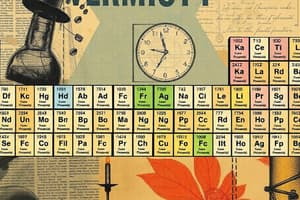Podcast
Questions and Answers
Which element has the most electronegativity?
Which element has the most electronegativity?
- Fluorine (correct)
- Sulfur
- Oxygen
- Nitrogen
What is the electronegativity of chlorine?
What is the electronegativity of chlorine?
- 3.5
- 2.5
- 2.2
- 3.0 (correct)
Why is oxygen more electronegative than sulfur?
Why is oxygen more electronegative than sulfur?
- Oxygen has more valence electrons than sulfur (correct)
- Oxygen has 2 energy levels, sulfur has 3
- The bonding electrons in sulfur are further away from the nucleus of the atom
- Oxygen has 8 protons in the nucleus whereas sulfur only has 7
What is the trend of electronegativity in a group?
What is the trend of electronegativity in a group?
What is the ability measured by electropositivity?
What is the ability measured by electropositivity?
Which statement best describes the trend of atomic size in the periodic table?
Which statement best describes the trend of atomic size in the periodic table?
What is the trend of ionization energies in the periodic table?
What is the trend of ionization energies in the periodic table?
What happens to the energy when an electron is added to a neutral atom in the gaseous state to form a negative ion?
What happens to the energy when an electron is added to a neutral atom in the gaseous state to form a negative ion?
What is the difference between a stable atom and an unstable atom?
What is the difference between a stable atom and an unstable atom?
Which factor affects the stability of an element when adding an electron?
Which factor affects the stability of an element when adding an electron?
Flashcards are hidden until you start studying




